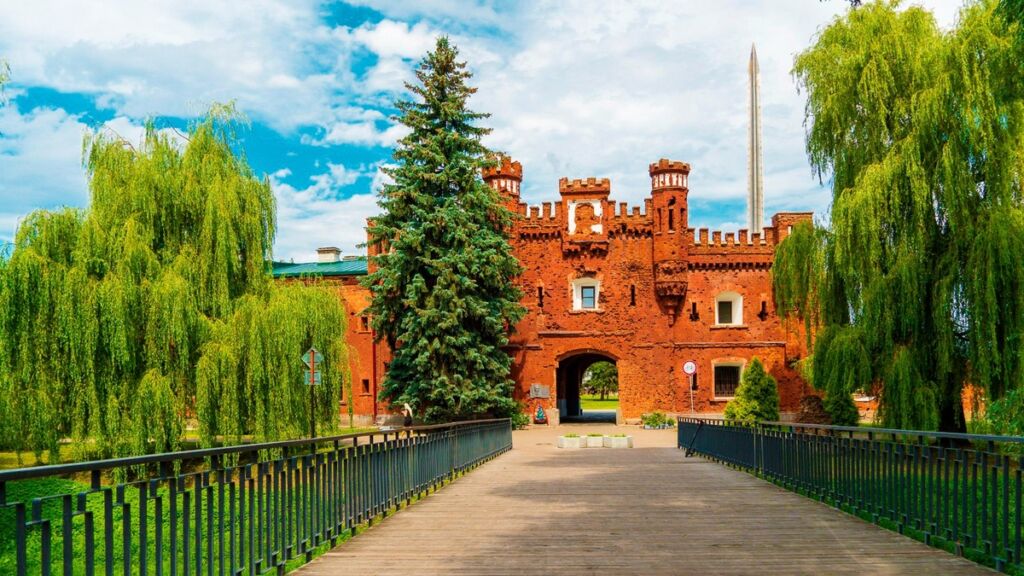Brest is a city in southwestern Belarus at the confluence of the Mukhavets and Bug rivers near the Polish border. Its administrative area covers 145 km2 and its elevation is about 160 m above sea level. The population stands at approximately 350 000 residents. Official languages are Belarusian and Russian, with Russian predominant in everyday communication and Belarusian used in cultural and educational contexts. English is spoken in hotels and among younger professionals. Sale of alcohol is legal from age 18; narcotics are banned and carry severe penalties. Brest holds the title of Hero City for its resistance during World War II and is recognized as a City of Military Glory. Licensed casinos operate under strict state regulation in major hotels.
History
Brest’s origins date back to at least the 10th century when Slavic tribes settled along the Bug and Mukhavets rivers. The first written mention appears in 1019–1020 in chronicles describing the capture of a wooden fortress by Grand Prince Yaroslav the Wise. In the 11th and 12th centuries Brest served as an important frontier outpost of Kievan Rus, defending trade routes toward Central Europe. By the 13th century the town had grown into a fortified settlement featuring earthen ramparts and wooden palisades. In 1319 Brest came under the rule of the Grand Duchy of Lithuania, which granted it Magdeburg rights in 1390, fostering self-government, market privileges and growth of craft guilds.
During the 16th century Brest became a significant trade hub of the Polish-Lithuanian Commonwealth. In 1569 the Union of Lublin transformed the duchy into a joint republic, and Brest evolved as a center for fairs trading furs, grain and salt. The city’s multiethnic population—Belarusians, Poles, Jews and Ruthenians—flourished culturally and economically. Religious tolerance under the Commonwealth allowed Orthodox, Catholic and Jewish communities to build churches, monasteries and synagogues.
The partitions of Poland at the end of the 18th century brought Brest into the Russian Empire. In 1795 it became the seat of Brest-Litovsk Governorate. Under Tsarist rule the city expanded with stone fortifications, a modernized citadel and new neighborhoods. The arrival of the Warsaw-Brest railway junction in 1871 fueled industrialization, leading to textile mills, tanneries and breweries. By the early 20th century Brest was a bustling frontier city connecting East and West.
World War I devastated Brest when German forces captured it in 1915. In 1918 the Treaty of Brest-Litovsk temporarily ended hostilities between Soviet Russia and the Central Powers. After the war the city changed hands between Poland and Soviet forces until the Peace of Riga in 1921 placed Brest in the Second Polish Republic as Brest-Litovsk. During the interwar period the city underwent modernization—new schools, hospitals and a regional railway hub—while cultural institutions preserved Belarusian, Polish and Jewish heritage.
The onset of World War II saw dual occupations. In September 1939 Poland’s retreating forces blew up sections of the fortress. Soviet troops entered under the Molotov-Ribbentrop Pact, annexing the city to the Byelorussian SSR. In June 1941 Nazi Germany occupied Brest, imprisoning and massacring most of its Jewish population and deporting thousands of Belarusians to forced labor. The city was liberated by the Red Army in July 1944 after fierce fighting around the fortress, earning the title Hero Fortress.
Postwar Brest lay in ruins—over 70 percent of buildings destroyed. Reconstruction followed Soviet urban planning: wide avenues, prefabricated apartment blocks and monumental public buildings. The rebuilt fortress became a memorial complex with museums and monuments commemorating wartime heroism. Industrial growth resumed with new machinery plants, food processing and light industry.
After Belarus declared independence in 1991, Brest revived its historic center through careful restoration of churches, synagogues and the Old Castle site. Cross-border trade with Poland accelerated after 2004 when Belarus joined the Eurasian Economic Community. Today Brest is both a guardian of memory and a dynamic regional center featuring universities, cultural festivals and growing tourism.
Industry
Brest’s economy centers on mechanical engineering, food processing and logistics. Major enterprises include a railway car repair plant, automobile service factories and dairy processing facilities. The city is a key freight hub on the Belarus-Poland border with large customs terminals and warehousing complexes. Light industry produces textiles, footwear and furniture.
Religion and Ethnicity
Ethnic Belarusians make up about 85 percent of the population, Russians 8 percent, Poles 4 percent and Ukrainians, Jews and others the remainder. Religious affiliation is roughly 65 percent Eastern Orthodox, 20 percent Roman Catholic, 5 percent Protestant and 2 percent Jewish with others non-religious. Traditions include major Orthodox and Catholic feast days, pilgrimages to the Church of the Nativity of the Theotokos and interfaith cultural festivals.
Wars and Conflicts
Brest’s strategic location invited multiple conflicts: Mongol raids in the 13th century, wars between Poland and Russia in the 17th century, Napoleonic invasion of 1812 and the Russo-Turkish wars. World War I saw German occupation from 1915 to 1918. In World War II the fortress’s defense and subsequent Nazi occupation led to immense civilian suffering and destruction.
Standard of Living
Residents enjoy a higher standard of living than in many Belarusian regions due to cross-border commerce. Per-capita income exceeds the national average. Transparency International lists Belarus around 80th worldwide for corruption perception; local administration enforces stricter anti-corruption measures. Public education, subsidized utilities and social benefits remain robust.
Medicine
Brest has a network of public clinics and a central hospital offering free basic care to citizens. Tourists should carry health insurance since private care requires payment. Hospitals maintain modern diagnostic equipment. Pharmacies are widespread; tap water is drinkable but many prefer bottled water due to taste preferences.
Sport
Football and ice hockey dominate local interest. FC Dinamo Brest competes in the Belarusian Premier League and plays at the regional stadium. Belarusian Cup finals have been held here. The ice hockey club HC Brest appears in national championships. Athletics, basketball and volleyball teams compete regionally. The city hosts annual rowing regattas on the Mukhavets River.
Holidays
New Year’s Day on January 1 and Orthodox Christmas on January 7 feature family gatherings and church services. International Women’s Day on March 8 is celebrated with gifts and flowers. Victory Day on May 9 includes parades at the fortress memorial. City Day in mid-September brings street fairs, concerts and fireworks. Independence Day on July 3 sees official ceremonies.
Traditions
Hospitality involves greeting guests with bread and salt. Visitors remove shoes when entering private homes. It is polite to offer a small gift when invited to dinner. Tourists should dress modestly in churches and cover heads in Orthodox sites. Respect for elderly and clergy is expected.
Interesting Facts
The Brest Fortress consists of three independent forts built in the 19th century. Scenes from the 1970 Soviet film “Hot Snow” were filmed here. In 1996 the first railway tunnel under Polish-Belarusian border was completed. In 2004 the city celebrated its millennium by planting 5000 oak saplings. In 2012 Brest hosted the European Rowing Under-23 Championships.
Money
The currency is the Belarusian ruble BYN. Credit cards are accepted in hotels, major shops and restaurants; ATMs are plentiful. Exchange rate is about2.60 BYN per USD. Banks offer the best rates; avoid street exchangers. Small vendors prefer cash. Tips of 5–10 percent in restaurants are appreciated but not obligatory.
Household Details
Electricity is 220 V at50 Hz. Plugs are types C and F. Mobile networks by A1, MTS and life:) cover the city with4G service. Free public Wi-Fi is available in parks and libraries.
Clothing
Dress is smart casual. In summer lightweight clothing suffices; winters require insulated coats, hats, scarves and gloves. In churches cover shoulders and knees; women should wear headscarves. On cobblestone streets closed-toe shoes are recommended.
Tourism
Tourism in Brest revolves around the fortress memorial complex, museums and riverfront promenades. Visitors start at the Main Gate of the Brest Hero Fortress, exploring underground casemates and war exhibits. The Museum of Railway Equipment displays historic locomotives. A stroll along Sovetskaya Street leads to the City Hall and Church of the Holy Spirit. The ethnographic complex at Brest’s open-air museum showcases traditional rural architecture. River cruises on the Bug offer scenic views of parks and the nearby woods. Culinary tours introduce local specialties at markets and family-run taverns. Seasonal festivals—harvest, crafts and music—bring lively open-air markets and folk performances. The border crossing to Poland allows day trips to Warsaw and Białowieża Forest.
Types of Tourism
Historical tourism focused on WW II and fortress architecture. Cultural tourism in museums and churches. Ecotourism in Belovezhskaya Pushcha National Park. Cross-border tourism into Poland. Culinary tours of Belarusian cuisine. River cruises and sporting event travel.
List of Tourist Attractions
Brest Hero Fortress –19th-century citadel turned WW II memorial
Brest Railway Museum – outdoor exhibits of steam and diesel locomotives
Sovetskaya Street – pedestrian thoroughfare of 19th-century mansions
Church of the Holy Spirit –Baroque cathedral built in the 17th century
Brest Region Museum – collections on local art, history and nature
List of Non-Tourist Attractions
Sosnovy Bir Microdistrict –Soviet-era apartment blocks showing daily life
Old Jewish Quarter – remnants of synagogues and narrow lanes
Abandoned military barracks near the airport
Woodworking factory neighborhood on the outskirts
Rural folk workshops along the Bug River
Local Cuisine
Draniki –potato pancakes served with sour cream or mushroom sauce
Kolduny –meat-filled dumplings in clear broth
Machanka –pork stew with thick crepe pancakes
Borscht –beet soup with vegetables and meat, topped with dill
Zavtrak –tea with jam or pastries for breakfast
Kvass, medovukha and local beers accompany meals. Dining hours: breakfast8–10 AM, lunch12–3 PM, dinner6–9 PM. Street stalls maintain good hygiene; bottled water is advisable. Tips of10 percent in restaurants are customary.
Why Visit
Brest offers a poignant blend of battlefield history, serene river landscapes and cross-cultural heritage. Its heroic fortress, restored old town and lively festivals immerse visitors in Belarusian resilience and hospitality at a reasonable cost.
Safety for Tourists
Crime rates are low; petty theft is the main concern. Terrorist threat is negligible. No dangerous wildlife in the city. CCTV covers major squares. Seasonal tick-borne encephalitis occurs in nearby forests; use repellents. Public hygiene standards are high and all nationalities are warmly received.
Tourist Infrastructure
Hotels range from five-star international chains to mid-range and budget guesthouses. Restaurants offer multilingual menus; staff in major establishments speak English and Polish. Tourist information centers provide maps and guided tour bookings.
Entry Rules
Most visitors require a visa unless eligible for a five-day visa-free entry via Brest airport. Passport must be valid for six months beyond departure. Prohibited items include narcotics, weapons and over10 000 USD in undeclared currency.
Transport
Local transport includes buses, marshrutkas and taxis. Tickets cost about0.50 BYN on buses; purchase from the driver. The railway station connects to Minsk, Warsaw and Vilnius. Bicycle rentals are available along the riverfront.
Automobile
International driving permits are recognized. Traffic drives on the right. No toll roads. Police bribery is rare but discouraged. Alcohol limit is0.03 percent. Speed limits:60 km/h in town,90 km/h outside. Speed cameras operate on main roads. SUVs and crossovers are ideal for rural excursions. Fines start at20 BYN.
Noise Regulations
Quiet hours run from22:00 to07:00 in residential zones. Silence required near hospitals and schools at all times.
Daily Budget
Budget travel:60–100 BYN (22–37 USD). Comfortable stay:150–250 BYN (55–92 USD).
What Not to Do
Do not photograph military installations. Avoid political demonstrations. Do not litter in parks. Driving under the influence is strictly forbidden.
Climate
Brest has a humid continental climate. Winters are cold and snowy with January averages around−4 °C. Summers are warm and humid, July averages +18 °C. Best months to visit are May through September.
Travel Tips
Ensure up-to-date tetanus and influenza vaccinations. Consider tick-borne encephalitis vaccine for forest outings. Carry travel insurance covering medical evacuation. Download offline maps and learn basic Russian phrases.
- How to follow Donald Trump’s travel trail
- Sydney
- Finland
- Chukchi
- Pirate places of the world: where to travel for seafaring legends
- Honduras
- Arabat Spit
- Rising prices for travel in Germany in 2025: reasons, scale and consequences
- Brest (Belarus)
- House of Russian-Korean Friendship Opened in Primorye on the Border with the DPRK
- Haruto Takahashi Found Pirate Treasure in Madagascar and Rowed It Home
- Indonesia
- Holiday in Monaco
- Glorious sea – sacred Baikal
- Scythians
- Africa
- Around Baikal by Car: A Grand Loop of Siberia’s Inland Sea
- Tasmania
- Kubachi (Dagestan, Russia)
- Baikal facts












